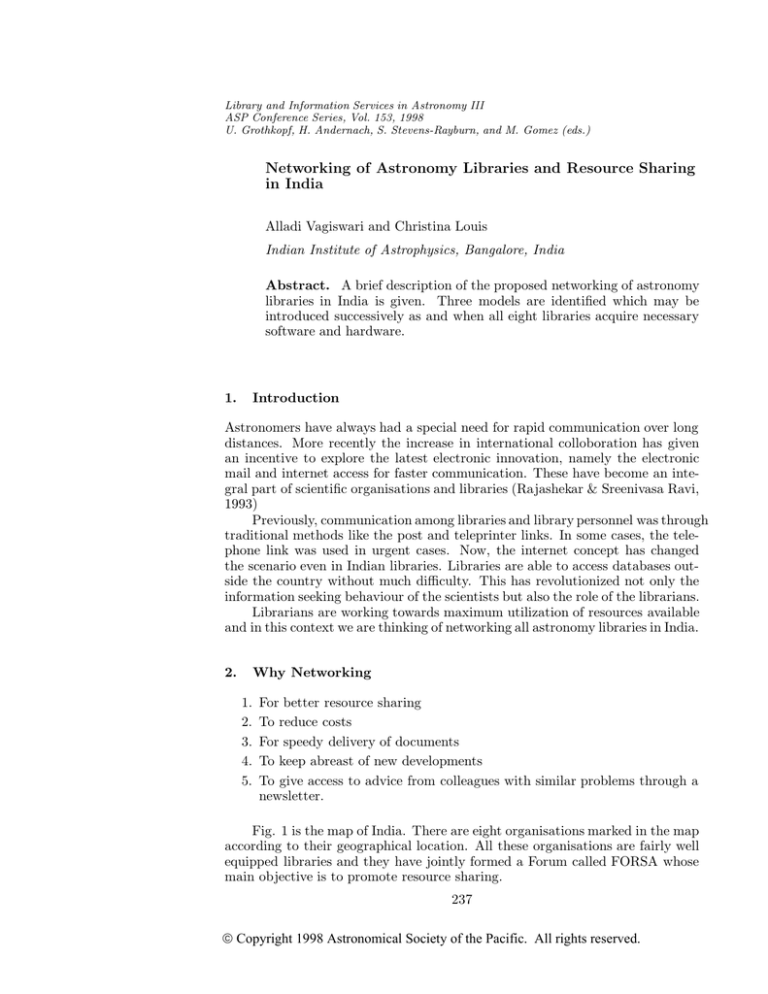
Library and Information Services in Astronomy III
ASP Conference Series, Vol. 153, 1998
U. Grothkopf, H. Andernach, S. Stevens-Rayburn, and M. Gomez (eds.)
Networking of Astronomy Libraries and Resource Sharing
in India
Alladi Vagiswari and Christina Louis
Indian Institute of Astrophysics, Bangalore, India
Abstract. A brief description of the proposed networking of astronomy
libraries in India is given. Three models are identified which may be
introduced successively as and when all eight libraries acquire necessary
software and hardware.
1.
Introduction
Astronomers have always had a special need for rapid communication over long
distances. More recently the increase in international colloboration has given
an incentive to explore the latest electronic innovation, namely the electronic
mail and internet access for faster communication. These have become an integral part of scientific organisations and libraries (Rajashekar & Sreenivasa Ravi,
1993)
Previously, communication among libraries and library personnel was through
traditional methods like the post and teleprinter links. In some cases, the telephone link was used in urgent cases. Now, the internet concept has changed
the scenario even in Indian libraries. Libraries are able to access databases outside the country without much difficulty. This has revolutionized not only the
information seeking behaviour of the scientists but also the role of the librarians.
Librarians are working towards maximum utilization of resources available
and in this context we are thinking of networking all astronomy libraries in India.
2.
Why Networking
1.
2.
3.
4.
5.
For better resource sharing
To reduce costs
For speedy delivery of documents
To keep abreast of new developments
To give access to advice from colleagues with similar problems through a
newsletter.
Fig. 1 is the map of India. There are eight organisations marked in the map
according to their geographical location. All these organisations are fairly well
equipped libraries and they have jointly formed a Forum called FORSA whose
main objective is to promote resource sharing.
237
Copyright 1998 Astronomical Society of the Pacific. All rights reserved.
238
A. Vagiswari and C. Louis
Figure 1.
3.
India – Astronomy Libraries
Participating Libraries
There are eight scientific institutions in India, for which astronomy is the major
research area.
3.1.
Indian Institute of Astrophysics Library (IIA)
It is more than 200 years old and has a rich collection of books and journals
in Astronomy and Astrophysics. Some of the astronomical journals start from
volume 1 dating back to the nineteenth century. The library has most of the
old observatory publications. They form an important part of the collection as
many astronomical catalogues are published here which are still used by our
scientists.
3.2.
Inter-University Centre for Astronomy and Astrophysics Library (IUCAA)
It is an autonomous institute, located in Pune, and has been established recently.
The main areas of research are Astronomy and Astrophysics, General Relativity
and Gravitation. Though the library of this institute is new, it has succeeded
in building up a very good collection of books and journals in Astronomy and
Astrophysics. The majority of astronomy journals are received by airmail at
IUCAA.
Networking and Resource Sharing in India
3.3.
239
National Centre for Radio Astrophysics Library (NCRA)
It has a wide collection of materials on radio astronomy and astrophysics. This
institute is located in Pune, close to IUCAA.
3.4.
Nizamiah Observatory Library
This Observatory is very old and functions under Osmania University, Hyderabad. The present library was established in 1961 and it has a fairly good collection of old books and journals. The Observatory has been receiving reprints
and publications from the beginning of this century from all over the world on
exchange basis, so the library is rich in old material.
3.5.
Physical Research Laboratory Library (PRL)
The Physical Research Laboratory, located in Ahmedabad, has a library, funded
by the Department of Space. The Institute carries out research in many areas
of Physics. In addition, it also concentrates on Astronomy and Astrophysics,
Infrared Astronomy and Radio Astronomy.
3.6.
Raman Research Institute Library (RRI)
The Raman Research Institute Library has been developed around the library
started by the nobel laureate Prof. Raman and is also located in Bangalore.
With his diverse interests in different branches of science and deep interest in
reading, Prof. Raman had added invaluable books to the library. It has a rich
collection of astronomy and astrophysics books. Its preprint collection is also a
valuable resource for sharing.
3.7.
Tata Institute of Fundamental Research Library (TIFR)
Tata Institute of Fundamental Research Library, Bombay was established in
1945. In addition to books in various branches of physics it has a large collection
of books and journals in the areas of astronomy, astrophysics and space physics.
3.8.
Uttar Pradesh State Observatory Library
Located in Nainital, the library has built up a vast collection of books and
journals in astronomy in the short span of 45 years and is very keen on expanding
its collection and services.
4.
What to Share
Books
Journals
Observatory Publications
Preprints
Catalogues
Lists of Publications
Recent Additions
Newsletters
Policy Decisions
FORSA Forum
Current Events
Newsflash
240
A. Vagiswari and C. Louis
Table 1 below gives the total collection and the services offered by the individual libraries. The table shows that four libraries have automated their library
catalogues using the same library software called LIBSYS and two libraries use
a software called SLIM. LIBSYS is a fully integrated multi-user library system
designed to run on a wide spectrum of hardware and software platforms and it
can also import databases built on other software (e.g. SLIM). This is one of
the important criteria which will make this networking feasible.
Table 1.
No.
1.
2.
3.
4.
5.
6.
7.
8.
Resources and Services available at FORSA libraries
Library
Software
Coll.Books
Coll.Jour.
Jnl.Sub.
IIA
IUCAA
NCRA
NIZA.OBS.
Library
PRL
RRI
TIFR
U.P.State
Obs.Lib.
LIBSYS 3.X
SLIM 2.0
SLIM 1.1
13,300
10,000
5,400
5,340
18,400
4,000
3,300
3,995
142
150
104
10
LIBSYS 3.1
LIBSYS 3.X
LIBSYS 3.2
Acquiring
LIBSYS
Total
16,500
19,613
55,000
8,273
25,000
23,273
56,000
8,061
197
137
656
76
133,426
142,029
From Table 1, it is evident that the collection of books and journals of all
the libraries put together is not very large and will occupy less than 2 GB space.
5.
Networking Models
1. Interconnecting all astronomy library homepages.
2. Creating an integrated library database.
3. Establishing connectivity using search-engine architecture.
5.1.
Model I
In this model, which is the simplest, the home pages of the participating libraries
will be linked.
Many research organisations in India have designed their home pages and
libraries are also a part of their homepages. Similarly, member libraries of
FORSA also have their independent web pages and they are accessible on the
internet. Since these web pages will exist independently, a scientist looking for a
document will be able to trace it eventually, if not immediately (Madalli 1998).
At present, only six libraries out of the eight FORSA libraries have internet
Networking and Resource Sharing in India
241
connection, but we hope that the other two libraries will be able to get their
home pages soon.
5.2.
Model II
In this model, the databases of all individual libraries will be merged. Since the
total collection of books is 133,426 and there are 142,029 journal volumes we
will not be requiring more than 2 GB space for an integrated database.
Figure 2.
Integrated Library Servers
The merging of books and journals will be effected with the help of a unique
feature like the ISBN numbers. Since the physical location is one of the fields
in the data entry form, it is not difficult to reflect it in the merged database.
This has a major advantage from the user’s point of view. It will be less timeconsuming, since the scientist will have to access only one server where the integrated database will be located (Fig. 2). The LIBSYS software, used in most of
the libraries, has the facility to display the availability status of the document.
It is mandatory for the library personnel to maintain, rather than update this
integrated database. It could either be a commitment from an exclusive group
of people or it could be done remotely from individual locations. We are also
planning to create a profile of all member libraries as the common web page,
which will be linked to the integrated database. In the event of any exclusive
feature of a particular library being listed, it is easier to access that feature
242
A. Vagiswari and C. Louis
from the common web page. For example, in our library we have many old
documents, which will be catalogued in a database and any individual interested
in the archival material can access that database from the common web page.
The availability of electronic journals will be another feature which could be
accessible only by the individual institute’s scientists, though it will be a listed
item in the common web page.
Incorporating too many icons and graphics in a web page is a time-consuming
factor at the time of retrieval. Keeping all this in mind, we will design soon our
common web page to facilitate an easy navigation and retrieval through the
internet, not only for our scientists, but also for the international community.
We are also gearing up our library staff to undertake training in handling the
network, especially hypertext linking. Though we have a very good technical
support from the software company, we are getting equipped with basic knowledge of software maintenance and also the optimum usage of the features of this
software.
Funding for this joint project is envisaged from member libraries and also
from the Department of Science & Technology of the Government of India.
5.3.
Model III
In model III, which is a sophisticated model, the databases will be connected
with the help of search-engine architecture. In the March 1997 issue of Scientific
American, Lynch (1997) describes one such model called HARVEST which derives indexing terms using software called “Gatherers” that reside at web sites.
By doing so, the search engine can avoid downloading all the documents from
a web site which would burden the network traffic. The search engine’s server
takes the help of the Gatherers to create a file of keywords that can be processed
into an index for querying by users. Lynch says that “eventually, the librarian’s
classification and selection skills must be complemented by the computer scientist’s ability to automate the task of indexing and storing information. Only
a synthesis of the different perspective brought by both professions will allow
this new medium to remain viable.” If this concept can be applied to the library database, it will be an efficient tool for future retrieval and international
co-operation.
6.
Conclusion
India has taken advantage of the wide range of scientific information available
through computerised networks. It has already geared up to having modern
communication facilities (including satellite communication), adequate electricity, subsidised communication costs, rationalisation of taxes on computer equipment, etc., which gives us a thrust to fully participate in the new information
age. The astronomy librarian of Australian National University has expressed a
desire to be a part of this network, thus extending the network to the Asia Pacific
region. When this network is realised, it will have a broader subject coverage to
include physics and and mathematics, along with astronomy. Eventually it will
be an international co-operation with more new ideas and suggestions.
Networking and Resource Sharing in India
243
References
Lynch, C., 1997, Scientific Amer., 276, no.3, 44.
Madalli, D.P., 1998, DRTC Workshop (31) on Practical Orientation to Internet,
Paper AA.
Rajashekar, T.B. and Sreenivasa Ravi A., 1993, DRTC - INSDOC seminar on
Library Networks in India, Paper U.





